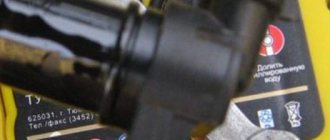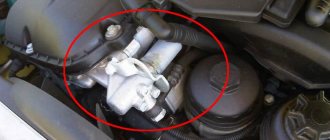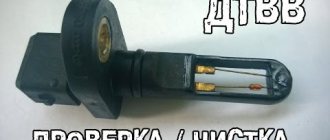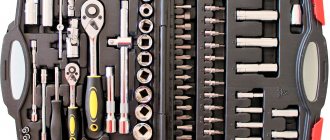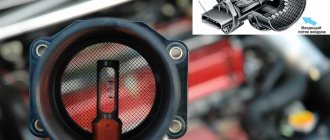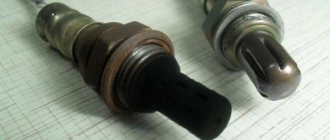Crankshaft sensor VAZ 2112
In the design of the VAZ 2112 engine, the crankshaft position sensor is an electromagnetic sensor through which the operation of the ignition system and fuel injectors is synchronized in the fuel injection system. Therefore, DPKV is actually the main one; without it, the operation of the entire fuel injection system becomes impossible. When a crankshaft sensor malfunction occurs on a VAZ 2112, this inevitably leads to unstable engine operation. It is very easy to identify faults and replace the DPKV by reading our article.
Operating principle and location
It should be noted that malfunctions of the crankshaft sensor (controller here and further in the text) are rare, however, when going on a long trip, it is better to have a spare working sensor, if the DPKV fails, then further driving of the car most often turns out to be impossible. Let's move on to the principle of operation:
- The toothed pulley of the electric generator drive is made in the form of a disk with 58 teeth around its circumference, located every 6 degrees
- In order to generate a speed synchronization pulse for the injector, two teeth are specially missing on the pulley
Scheme of operation of a sensor with a pulley
- The car is equipped with either an all-metal pulley or a pulley with a damper (rubber insert)
- All-metal pulleys are practically not subject to wear during engine operation.
- You only need to ensure that there is no dirt or foreign particles between the teeth
- If the pulley has a damper, then you need to monitor the condition of the damper; damage to the damper will definitely lead to problems with engine operation
- When performing repair work, you must be careful not to subject the pulley to deformation; deformation can lead to interruptions in the operation of the motor.
- You can visually check the condition of the generator drive pulley by looking through the front right wheel arch
- In our case, the engine has an all-metal pulley
- If a malfunction occurs in the crankshaft position controller, or the drive pulley of the electric generator, as well as the timing drive, the computer may record an error, which will be reflected by the “CHECK ENGINE” light coming on.
- And enter the corresponding code “35” or “19” into the error buffer
The following symptoms characterize the occurrence of malfunctions of these elements:
- Unstable engine speed at idle
- There is a spontaneous decrease or increase in engine speed
- Complete stop of the engine and complete inability to start the engine
- Noticeable decrease in engine power
- The appearance of detonation under standard dynamic loads, as well as misfiring (motor trouble)
The question remains for the VAZ 2112 where the crankshaft sensor is located, the answer is - it is located on the oil pump cover.
Location of the crankshaft position controller
Replacing chips and pinout of DPKV VAZ 2110
Over time, the wires going to the DPKV chip wear out. Located in the lower part of the engine and not far from the front wheel, as a result, dirt, snow, oil, and aggressive chemical media in the form of salt get on the DPKV and its chip and settle, which leads to slow oxidation of the wires on the chip and subsequently to their breakage. Since the wires from the chip are combined into a single bundle, when replacing it, a repair chip is provided with protruding two wires 15 cm long. Having removed the damaged chip, install a new one with a twist. The twist points are insulated using heat shrink or electrical tape.
From the diagram below it can be seen that their pinout is not complicated and two wires are directly connected to the signal input contacts in the control unit, passing along the entire length of the harness. The polarity of the connection between the signal wires of the sensor and the control unit must be observed. If the polarity is reversed, the synchronization system will not work. To restore the operation of the DPKV, you simply need to swap the wires and check the functionality by starting the engine.
Signs of DPKV malfunction
How to determine that the crankshaft position sensor on a VAZ 2112 is broken, and not something else:
- A strong decrease in the dynamic characteristics of the engine while the car is moving (there can be many reasons for this problem, but this is the kind of malfunction that the computer will report, which, having detected the problem, will light up the “check engine” light on the dashboard)
- If the engine speed spontaneously “walks” (decreases or increases)
- Idle speed instability
- The appearance of detonation in the engine under dynamic load
- The engine cannot be started
Here are the main characteristic symptoms of a breakdown of the crankshaft speed controller, or a generator drive pulley, or timing problems. From the very beginning, you need to understand how you can perform a high-quality test of the performance of the DPKV yourself and be one hundred percent sure that everything is in order with it. Why should this check always be performed first? Everything is simple here, even without looking at the fact that the controller is located in an inconvenient place, our instructions for checking its functionality will help you complete everything quickly enough. And after checking it will be clear whether the controller needs to be changed.
Features of testing on other cars
As for other cars, for example, VAZ-2109 with an injection engine, VAZ-2112 and VAZ-2114, their check is carried out identically to the VAZ-2110 car.
It is noteworthy that for VAZs, when checking the resistance of the crankshaft sensor coil, an additional check can be carried out.
But to do this, the multimeter must be switched to voltmeter mode with a measurement limit of 200 mV.
Then connect the probes to the DPKV terminals and pass them with any metal object, for example, a screwdriver, at a short distance from the core.
If the sensor is working properly, it will react to metal, the multimeter will show voltage surges on the display. The absence of these bursts will indicate a faulty element.
As for a car like the Reno Logan, the difference from the VAZ in this car comes down to slightly different readings of the resistance of the sensor coil when measured with an ohmmeter.
A working Logan DPKV has a normal resistance of 200-270 Ohms.
For Daewoo Lanos, the coil resistance should be in the range of 500-600 Ohms.
But on the ZMZ-406 engine, installed on Volga and Gazelle cars, the normal coil resistance is in the range of 850-900 Ohms.
Performing a check
You can determine the serviceability of (DPKV) in several ways. Each method requires the use of special devices. Most often, three main methods are used to check the performance of the crankshaft speed controller, let's look at them in order:
- Listening to the advice of professionals, before checking it is always necessary to remove it by unscrewing the fastener of the VAZ 2112 crankshaft sensor, do not forget to fix its initial position on the engine with marks
- Everyone understands that it is necessary to inspect it after removal
- Visual inspection makes it possible to detect external damage on it
- And understand the condition of its contact block and the core of the contacts themselves
- Dirt should be removed from it using alcohol or gasoline.
- The contacts at the crankshaft controller must be clean
- During the removal process, it is necessary to clearly mark the distance from the controller core to the synchronization disk
- Typically it varies from 0.6 millimeters to 1.5 millimeters
- If there are no visible problems, you need to move on to identifying hidden problems in the electrical circuit of this device
Diagnostics using an ohmmeter
To measure the resistance of the crankshaft controller winding, you can use an ohmmeter (multimeter):
- A normally operating controller will show values ranging from 550 Ohms to 750 Ohms
- This test with a multimeter consists of measuring the resistance of the controller inductor
- If the coil is damaged, the sensor characteristics are displayed on the resistance first
- We set the required range and check the resistance with tester probes at the terminals
- This check is the simplest and most basic, so it does not give 100% confidence in the correctness of the diagnosis.
- In order not to doubt the actions being performed, carefully study the instructions included with your car before starting work.
- If the obtained measurement indicators do not fit into the declared interval, then it is necessary to replace the crankshaft speed controller
The second method of checking the performance of the DPKV is more labor-intensive and to implement it, you will need the following devices:
- Megger
- Inductance meter
- Network transformer
- Digital voltmeter
For the reliability of the obtained indicators, the air temperature is important, preferably 20-22 degrees, we do the following:
- We measure the winding resistance with an ohmmeter, as before
- Then we move on to checking the winding inductance using a special meter
- The inductance of a working meter is in the range of 200-400 MegaHertz
- Next, we’ll use a megger and move on to checking the insulation resistance
- At a voltage of 500 Volts, this parameter should not exceed 20 MegaOhm
- If accidental magnetization of the synchronization disk occurs during sensor repair, then you should definitely demagnetize it using a network transformer
- Having analyzed all the data obtained as a result of these measurements, we can draw a conclusion about the performance of the crankshaft controller or the need to replace it
- When installing a new or old device in its place, do not forget to pay very close attention to the marks left during dismantling, remember the need for a distance of 0.5-1.5 millimeters from the controller core to the synchronization disk
DPKV check diagram
- The third method of checking the crankshaft speed controller is the most accurate of all and is used, as a rule, at professional stations
- Since it requires an oscilloscope and a special program
- This method does not require removing the device from the engine.
- Since it allows you to see the signal formation on the screen
- Therefore, the presence of a digital oscilloscope helps specialists to effectively identify various problems that have arisen in the injection system
Diagnostics with an oscilloscope
The third method is not available to everyone, since oscilloscopes are not available everywhere and not everyone can be satisfied with the price:
- To get correct readings, you need to take the black clamp of the oscilloscope, the so-called “crocodile”, and connect it to the ground of the motor of the machine being tested
- The probe probe is installed parallel to the signal output of the sensor (controller connector - terminal A)
- And the second connector of the probe from the oscilloscope must be connected to the analog input No. 5USB of AutoscopeII
- These actions must be performed in order to see on the screen voltage oscillograms at the input of the crankshaft position controller
- Then you need to enable the oscillogram display mode called “InductiveCrankshaft”
- Only now can you start the car
- When it is impossible to start the engine, then it is necessary to rotate the engine with the starter
- If the signal from the crankshaft position controller is received, but the signal output parameters do not match the nominal ones. Then the car may twitch, and it may be difficult to start its engine, failures
- Violations of the characteristics of the outgoing signal from the crankshaft controller indicate existing malfunctions of either the controller itself or the drive disk and possible breakage of the teeth
- The true assumption about the nature of the malfunction becomes clear when considering the waveform on the oscillogram of the voltage pulses, which are recorded at the output of the crankshaft position controller
And so you have become familiar with all three possible methods for checking the crankshaft controller (sensor):
- Using an Ohmmeter (measuring winding resistance);
- Using a tester (checking insulation resistance and inductance);
- Using an oscilloscope
It is up to you to decide which methods to check according to your capabilities. The main thing is to be objective in obtaining results, careful and very attentive when checking
Comprehensive check for Opel Vectra B
Now let's take another car and use it to consider the last of the verification methods - comprehensive.
This test is much better than with a conventional multimeter, but in terms of accuracy it is not as accurate as an oscilloscope.
The problem car will now be the Opel Vectra B. We leave the symptoms the same.
The initial work is also no different from the VAZ-2110: the sensor is removed, inspected, thoroughly washed, and only after that you can start checking the condition.
But for a comprehensive check you will need more equipment:
- Multimeter;
- Megaohmmeter;
- Device for measuring inductance.
It is better to take all measurements in a heated room so that the readings are correct.
First, the coil resistance is measured, as described above. Resistance readings must be within the range specified in the technical documentation.
The next check is to measure the winding inductance, for which a device is used to measure it. A working DPKV inductance should be in the range of 200-400 mH.
The devices are pictured below.
The insulation resistance is also checked with a megohmmeter. When a voltage of 500 V is applied, the resistance value of the sensor should be no more than 20 MΩ.
Based on these measurements, it is determined whether the DPKV is working or requires replacement.
Photos of the devices are below.
Replacing the sensor
To remove the crankshaft position controller you will need a “10” key. The removal procedure is as follows:
- Turn off the ignition and disconnect the sensor connector
- Unscrew the bolt securing the sensor using the “10” key, photo below
We unscrew the DPKV using the key “10”
- Remove the DPKV from the oil pump cover bracket
- We install the tested or new controller in place in the same way
- Brand of crankshaft position sensor VAZ 21124 according to catalog 2112-3847910
That's all, the video will help you further understand the verification.
How to independently replace the crankshaft sensor on a VAZ 2112 car
Required materials and tools:
- key to “10”;
- head, knob;
- rags;
- additional lighting as needed;
- new DPKV;
- flat head screwdriver.
Regulations:
- We place the car on the inspection channel, secure the wheels with wheel chocks, and squeeze the parking brake;
- from the end of the engine, in the area where the oil pump is located, use a screwdriver to pry up the block with terminals, remove it, and move it to the side;
- Unscrew the screw (to “10”) - the clamp from the sensor;
- remove the controller;
- We carry out troubleshooting of the seat, wipe it, clean it from residual dust and dirt;
- insert a new controller;
- screw it in and assemble the structure in reverse order.
DIY replacement completed.
Bottom line
No matter what kind of car you own, if it has an injection engine installed, then problems with the engine’s operation due to DPKV are quite possible.
Experienced car enthusiasts always keep a spare sensor in their car so as not to be taken by surprise.
After all, it is much easier to install a new element and drive on, and then check the removed one for functionality, than at the most unexpected moment to encounter the fact that the car refuses to work normally due to such a small but very important element as the engine crankshaft position sensor.
Where is the crankshaft position sensor located?
This component is located in a bracket, which is installed in the central area of the pulley on the generator drive. As a rule, on most modern cars it is not installed end-to-end, but with a gap of 1-1.5 mm near the structure of the toothed pulley itself.
For ease of disconnecting and adjusting the DPKV, a 50-70 cm wire is connected to it, which has the necessary connectors for keys. To align and adjust the position, you only need to adjust the washer secured above the seat of the element itself. Adjusting the washer can be done either by you yourself or by specialists at a car service center - in any case, it will allow you to avoid early breakdown of the engine cylinders and significantly reduce fuel consumption.
If a malfunction occurs in the crankshaft sensor, the vehicle’s on-board computer is unable to set a number of characteristics necessary for the operation of the ignition system:
- Calculate the amount of fuel required for injection;
- Determine the right moment for injection;
- Change the angle of rotation of the camshaft;
- Determine whether ignition has occurred or not (relevant for gasoline engines).
Advice:
The occurrence of ignition problems affects the operation of all vehicle systems. Often, after the fuel system, the steering rack on the VAZ-2114 begins to break down.
Crankshaft position sensor design
The design of the DPKV is simple and consists of a small number of elements. In particular, its main element is a magnetized steel core on which a thin copper wire is wound. On top they are covered by a plastic (plastic) case. Naturally, in a copper winding, all the wires are insulated from each other (this can be implemented in different ways, for example, through compound resin or conventional insulation made of PVC or other material).
Operating principle
devices is as follows. In the immediate vicinity of the sensor, a “monitoring” disk with teeth around the perimeter rotates. Two of them are missing, creating a kind of emptiness. The main task of the sensor is to record the passage of this section and send appropriate signals to the ECU. If it does this late or with a weak signal, the electronic unit will provide incorrect information to the fuel system, and a mixture of suboptimal composition will be formed.
Device and classification
Despite the fact that the VAZ crankshaft sensor may have a different design, its operating principle is based on a single electromagnetic effect. That is, the signal is generated without direct contact with the crankshaft.
The most common type of DPKV is induction. Such a part consists of two main elements - a magnetized rod and a special winding. Induction sensors read information from the crankshaft. When a metal tooth passes near the DPKV, an EMF is formed in the latter, which is captured by the electronics. On the VAZ-2110, the crankshaft sensor is installed of the induction type.
DPKV can also be based on the Hall effect. Such a sensor is constructed in approximately the same way as an induction sensor, however, when a metal shaft passes near it in the winding of the device, the resistance changes. Structurally, it consists of a permanent magnet.
It should be noted that both the first and second types of sensors are used to read data from the crankshaft pulley. It can be toothed or all-metal. In the latter version, there is a special recess that passes by the sensor and generates a signal that is sent to the vehicle’s electronic engine control unit.

